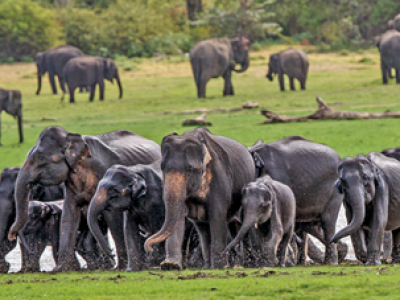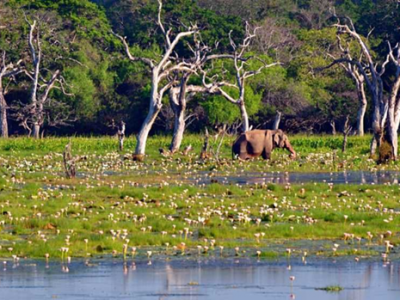The All-Inclusive Guide to Kaudulla National Park
If you have a soft spot for tropical flora and animals, you should definitely make a trip to Kaudulla National Park in Sri Lanka.
In the center of the cultural triangle, you’ll find Kaudulla, a national park that was just proclaimed in 2002. Located next to Minneriya Wildlife Park, this park has a total area of 6656 hectares and shares a corridor with its neighbor. Wildlife, especially elephants, may be seen in great numbers in this park. The landscape varies greatly from hilly to flat to forested to scrubby and back again. There is even a large area of grassland near the Kaudulla reservoir.
The Kaudulla National Park is one of the most notable of Sri Lanka’s 26 national parks. Its enormous land area is home to a wide variety of wildlife, including both land-based and water-based species, as well as a wide variety of rare and unusual birds. You can see more of Sri Lanka’s wildlife, including elephants, in the Somawathie Chaitiya Park and the Minneriya Wildlife Park, both of which are attached to the Kaudulla National Park.
Kaudulla National Park history
Kaudulla was constructed as one of King Mahasen’s 16 irrigation tanks in the region. It had been abandoned for some time before its 1959 reconstruction. Large animals, fish, and reptiles are just some of the new species that have found a home there. As an additional aspect of the “elephant gathering” at Minneriya National Park, Kaudulla is providing critical help.
Many elephants travel easily between the parks because of their closeness and the fact that they share forest habitats. When there is a drought in Sri Lanka, the elephants go to the Minneriya tank to eat and drink.

Kaudulla landscape features
Dry evergreen forests predominate in the park’s ecology. Traditional shifting crop cultivations and grasslands spread around the tank region. You’ll have a clear shot at seeing the animals you’re trying to picture. The park is home to 160 different species of birds, 24 different species of animals, 25 different species of reptiles, and 26 different species of fish. Elephants, birds, and other species are much easier to detect at the tank during the dry season because they congregate there for water. The park is home to a wide variety of mammalian species, such as the Sri Lankan leopard, sambar deer, Axis deer, chevrotain, wild boar, and sloth bear.
Kaudulla National Park is an Important Bird Area (IBA) because it is home to both wetland species like the spot-billed pelican and dryland birds like the Sri Lankan green pigeon. Indian flap shell turtles, Indian black turtles, and the unique frog Fejervarya pulla all call this tank home.

Kaudulla National Park Safari: What to Expect
In this park, you may see more Asian elephants than in any other single location on Earth, so much so that it has earned the nickname “The Gathering.” Elephants are most visible during the dry months of July through December. Though the park is small, visitors may expect to see elephants at any time of year.

Within that area, you may visit not one but three national parks in small steps. You may visit Minneriya National Park, Kaudulla National Park, and Hurulu Eco Park. Locals and visitors from other countries go to all three parks to see the massive elephant populations. Large herds of elephants may often be seen in the Minneriya National Park from July to September. However, in October and November, when the lakes are filling up from heavy rains, they move to Kaudulla National Park.
Climate in Kaudulla
On average, the park receives between 1500 and 2000 millimeters (mm) of rainfall annually. Predominantly, the northeastern monsoons are responsible for the precipitation. Between the months of April and October, the weather is often dry. Annual temperatures are typically in the range of 20–24.5 degrees Celsius.
How to get to Kaudulla National Park
- The Colombo-Trincomalee highway provides direct access to Kaudulla National Park. From Trincomalee, you may take a taxi straight to the park.
- A night train departs from Trincomalee and arrives at Galoya Junction, the terminal station for the 2-hour trip to Kaudulla National Park. It takes around twenty minutes to walk up to the park from Galoya Junction, or you may hire a cab.
- The cab ride from Dambulla to Kaudulla National Park takes around 42 minutes and covers the 44 kilometers between the two locations.
What’s the best time to visit Kaudulla National Park
In September and October, after the time of the famed elephant gathering at Minneriya National Park, the number of elephants in Kaudulla National Park reaches a high of over 200. So this makes it the best time to visit the park. Nevertheless, visitors to any of these parks may view elephants throughout the year.
The Hurulu Eco-Park, located on the outskirts of the vast Hurulu Biosphere Reserve west of the Habarana-Trincomalee road, is open daily from 2:00 to 6:30 p.m. It too provides opportunities to see herds of elephants outside of the peak wildlife viewing season, when visitors flock to nearby Kaudulla and Minneriya National Parks. Compared to the massive Minneriya reservoir and the much larger Kaudulla reservoir, the small reservoir at Hurulu Eco Park seems almost minuscule. However, from January through March, at least 30 elephants could be sighted.

Wrapping up
If you compare the Kaudulla to Sri Lanka’s other national parks, you’ll notice that there are surprisingly few Jeeps there. Unlike Yala National Park, where you may go glamping, this park is not touristy at all. It has fantastic wildlife without prohibiting overnight stays. On the drive back to your accommodation, you may be fortunate enough to see some elephants strolling along the roadside. The flora and fauna make Kaudulla one of the best choices to go on the bucket list of any wildlife lover. Visiting the park in the “best time of the year” can reveal so much more than at other times of the year.


Customer
Wow, superb blog format! How long have you been blogging for? you make blogging glance easy. The full glance of your web site is fantastic, let alonesmartly as the content!
Customer
Wow, that’s what I was seeking for, what a information! present here at this webpage, thanks admin of this site.
Customer
I know this site provides quality based posts and other stuff, is there any other web site which offers such things in quality?
Customer
It’s really a nice and helpful piece of information. I’m satisfied that you shared this helpful info with us. Please stay us informed like this. Thank you for sharing.
Customer
Pretty! This was a really wonderful post. Thanks for providing this info.
Customer
What’s up, constantly i used to check webpage posts here early in the dawn, as i like to gain knowledge of more and more.
Customer
I’m impressed, I must say. Rarely do I encounter a blog that’s equally educative and interesting, and let me tell you, you have hit the nail on the head. The issue is something that not enough folks are speaking intelligently about. I’m very happy that I found this in my search for something relating to this.
Customer
Can I just say what a relief to discover somebody who truly knows what they’re talking about on the internet. You definitely know how to bring an issue to light and make it important. More people ought to read this and understand this side of the story. I can’t believe you aren’t more popular since you definitely have the gift.
Customer
Hi there, yup this piece of writing is really pleasant and I have learned lot of things from it concerning blogging. thanks.
Customer
You can definitely see your enthusiasm in the article you write. The arena hopes for more passionate writers like you who aren’t afraid to mention how they believe. All the time go after your heart.
Customer
I blog frequently and I really appreciate your content. This article has really peaked my interest. I will book mark your site and keep checking for new information about once a week. I subscribed to your RSS feed as well.
Customer
I know this if off topic but I’m looking into starting my own blog and was wondering what all is required to get set up? I’m assuming having a blog like yours would cost a pretty penny? I’m not very internet savvy so I’m not 100% sure. Any recommendations or advice would be greatly appreciated. Thank you
Customer
My spouse and I absolutely love your blog and find many of your post’s to be just what I’m looking for. Does one offer guest writers to write content for yourself? I wouldn’t mind composing a post or elaborating on a few of the subjects you write in relation to here. Again, awesome weblog!
Customer
We stumbled over here different website and thought I might as well check things out. I like what I see so now i am following you. Look forward to going over your web page again.
Customer
I was more than happy to discover this site. I wanted to thank you for your time for this wonderful read!! I definitely loved every little bit of it and I have you book-marked to check out new stuff on your blog.
Customer
Hey I know this is off topic but I was wondering if you knew of any widgets I could add to my blog that automatically tweet my newest twitter updates. I’ve been looking for a plug-in like this for quite some time and was hoping maybe you would have some experience with something like this. Please let me know if you run into anything. I truly enjoy reading your blog and I look forward to your new updates.
Customer
This is the right web site for anybody who really wants to find out about this topic. You understand so much its almost hard to argue with you (not that I actually would want toHaHa). You definitely put a brand new spin on a topic that has been written about for many years. Great stuff, just great!
Customer
I am extremely impressed with your writing skills and also with the layout on your blog. Is this a paid theme or did you customize it yourself? Either way keep up the nice quality writing, it’s rare to see a nice blog like this one nowadays.
Customer
I’m really enjoying the design and layout of your blog. It’s a very easy on the eyes which makes it much more enjoyable for me to come here and visit more often. Did you hire out a designer to create your theme? Excellent work!
Customer
Howdy! I know this is kinda off topic nevertheless I’d figured I’d ask. Would you be interested in exchanging links or maybe guest writing a blog article or vice-versa? My site goes over a lot of the same subjects as yours and I believe we could greatly benefit from each other. If you happen to be interested feel free to send me an e-mail. I look forward to hearing from you! Awesome blog by the way!
Customer
After looking over a few of the blog posts on your web page, I honestly like your way of blogging. I bookmarked it to my bookmark website list and will be checking back soon. Please check out my web site as well and let me know what you think.
Customer
What’s Taking place i’m new to this, I stumbled upon this I have found It positively helpful and it has helped me out loads. I am hoping to give a contribution & assist other users like its helped me. Good job.
Customer
The UK summer is synonymous with muddy festivals. This means buying adequate clothing, camping gear and waterproof wellies.